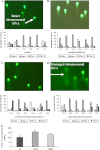Predictive molecular profiling in blood of healthy vasospastic individuals: clue to targeted prevention as personalised medicine to effective costs
- PMID: 23199064
- PMCID: PMC3405317
- DOI: 10.1007/s13167-010-0032-3
Predictive molecular profiling in blood of healthy vasospastic individuals: clue to targeted prevention as personalised medicine to effective costs
Abstract
Paradigm change from late interventional approach to predictive diagnostics followed by targeted prevention before manifest pathology, presents innovative concept for advanced healthcare. Preselection of healthy but pathology-predisposed individuals is the primary task in the overall action. Vasospasm is a frequent syndrome defined as an inappropriate constriction or insufficient dilatation in microcirculation. Vasospastic individuals are considered as healthy subpopulation predisposed to several pathologies including neurodegeneration. Clinical observations, subcellular imaging and "gene hunting"-investigations provide evidence for vasospasm as predisposition to glaucoma; development of further related pathologies cannot be excluded. Predictive molecular-profiling in blood can specify individual predisposition for effective prevention.
Figures




Similar articles
-
Common origin but individual outcomes: time for new guidelines in personalized healthcare.Per Med. 2010 Sep;7(5):561-568. doi: 10.2217/pme.10.42. Per Med. 2010. PMID: 29776246
-
Vasospastic individuals demonstrate significant similarity to glaucoma patients as revealed by gene expression profiling in circulating leukocytes.Mol Vis. 2009 Nov 14;15:2339-48. Mol Vis. 2009. PMID: 19936302 Free PMC article.
-
Mitochondrial impairments in aetiopathology of multifactorial diseases: common origin but individual outcomes in context of 3P medicine.EPMA J. 2021 Mar 4;12(1):27-40. doi: 10.1007/s13167-021-00237-2. eCollection 2021 Mar. EPMA J. 2021. PMID: 33686350 Free PMC article. Review.
-
Time for new guidelines in advanced diabetes care: Paradigm change from delayed interventional approach to predictive, preventive & personalized medicine.EPMA J. 2010 Mar;1(1):3-12. doi: 10.1007/s13167-010-0014-5. Epub 2010 Mar 16. EPMA J. 2010. PMID: 23199036 Free PMC article.
-
Vasospasm, its role in the pathogenesis of diseases with particular reference to the eye.Prog Retin Eye Res. 2001 May;20(3):319-49. doi: 10.1016/s1350-9462(00)00028-8. Prog Retin Eye Res. 2001. PMID: 11286896 Review.
Cited by
-
The role of the personality traits and work characteristics in the prediction of the burnout syndrome among nurses-a new approach within predictive, preventive, and personalized medicine concept.EPMA J. 2018 Oct 25;9(4):355-365. doi: 10.1007/s13167-018-0151-9. eCollection 2018 Dec. EPMA J. 2018. PMID: 30538787 Free PMC article.
-
Predictive, Preventive and Personalised Medicine as the hardcore of 'Horizon 2020': EPMA position paper.EPMA J. 2014 Apr 7;5(1):6. doi: 10.1186/1878-5085-5-6. EPMA J. 2014. PMID: 24708704 Free PMC article.
-
Impaired wound healing: facts and hypotheses for multi-professional considerations in predictive, preventive and personalised medicine.EPMA J. 2017 Mar 3;8(1):23-33. doi: 10.1007/s13167-017-0081-y. eCollection 2017 Mar. EPMA J. 2017. PMID: 28620441 Free PMC article. Review.
-
Flammer syndrome.EPMA J. 2014 Jul 8;5(1):11. doi: 10.1186/1878-5085-5-11. eCollection 2014. EPMA J. 2014. PMID: 25075228 Free PMC article. Review.
-
Key molecular pathways affected by glaucoma pathology: is predictive diagnosis possible?EPMA J. 2010 Jun;1(2):237-44. doi: 10.1007/s13167-010-0031-4. Epub 2010 Jun 29. EPMA J. 2010. PMID: 23199062 Free PMC article.
References
-
- Flammer J. Glaucoma. A guide for patients. An introduction for care providers. A quick reference. 3rd revised edition. Bern, Hogrefe & Huber Publishers, 2006
-
- Wunderlich K, Zimmerman C, Gutmann H, et al. Vasospastic persons exhibit differential expression of ABC-transport proteins. Mol Vis. 2003;9:756–761. - PubMed
LinkOut - more resources
Full Text Sources

